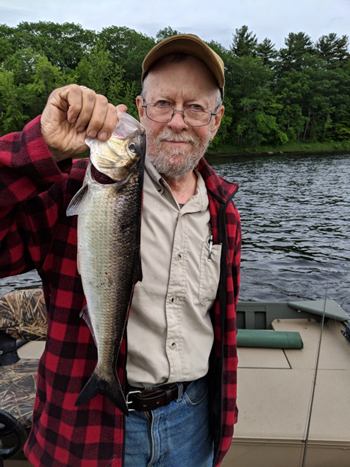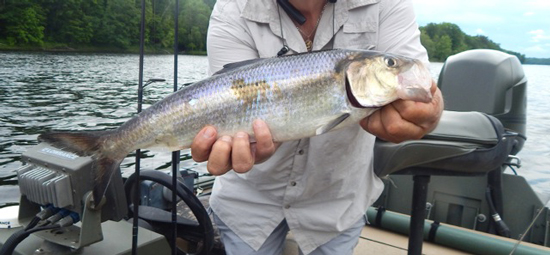American Shad Return to Maine’s Rivers
by Tom Seymour

Tom Seymour with a shad typical of several caught in an afternoon on the Kennebec River. Shad have responded in a big way to the Clean Water Act of 1970 and dam removals in Maine. Tom Seymour photo.
American shad, Alosa sapidissima, have made a great comeback and are returning to Maine’s rivers in great numbers. Once a viable commercial species as well as a favorite of recreational anglers, shad numbers had dwindled to a dangerous low over the last 150 or so years.
The culprits were dams and pollution. The Clean Water Act of 1970 has worked remarkably well in removing pollutants from Maine rivers and now these once-despoiled rivers run clean, some for the first time in over 150 years. According to the Maine Department of Marine Resources in their American Shad Habitat Plan, “it is not thought that poor water quality remains a threat in most known spawning/rearing locations.” And a push toward dam removal where possible has opened access to shad and other diadromous fish that hadn’t used many of these waters since the 19th century. In other cases, dams have been retrofitted with modern fishways and fish are taking advantage of them.
When a dam is removed, Edwards Dam in Augusta, for example, something amazing happens. Shad suddenly realized that they could venture upstream to their historical spawning grounds and did so in a big way. Even better, the runs increase each year, pointing the way to a rebirth of a once-doomed fishery.
The first to benefit from the restored shad fishery, recreational anglers are re-discovering the fighting qualities of shad and now, in places where no one has wet a line in years, anglers are catching shad. Since shad are a desirable food species, Mainers are learning new and old ways to prepare them. Shad roe, too, is deemed a delicacy.
Shad History
The burgeoning shad
fishery is only just now
gaining recognition among fisheries managers.
Historical records of commercial landings of American shad serve to show us the possibilities that may lie ahead because of river restoration efforts. Charles G. Atkins, an early (1867) commissioner of the Maine Department of Fish And Game (a forerunner of the modern Department of Inland Fisheries & Wildlife), kept notes and records regarding anadromous fish species and these records help us today to realize the enormity of the shad fishery in past years.
Atkins’ records are recorded in the fall, 1965 issue of Maine Fish and Game Magazine. From them, we learn that “in 1867, the Merryspring Bay district produced 180,000 shad per year and the estimated catch for the whole Kennebec in that year was 225,000 fish.”
Also, the “History of Penobscot County, Maine” printed in 1882, by Henry A. Ford, tells us that “some idea of the immense quantities of fish at the head of tide can be formed when it is understood that in 1827, 7,000 shad and 100 barrels of alewives were taken in one haul of the seine about the middle of May. Shad were sold at Old Town at five cents a hundred, and alewives were barely worth saving.”
You expand these rivers,
you open up these rivers,
and the fish respond.
– Pat Keliher, Maine DMR
Even in recent years, commercial fishermen off Matinicus Rock have taken shad as a bycatch when fishing for other species. This bycatch continues in various places off the Maine coast and in time, the shad fishery may become much more than just a bycatch fishery. But it will take some time and considerable research for that to happen. As it is, the burgeoning shad fishery is only just now gaining recognition among fisheries managers. But that, too, is changing.
Pat Keliher, commissioner of the Maine Department of Marine Resources said in 2016, “We had so little information on what was happening with shad in the (Penobscot) River that we didn’t know what to expect. It wasn’t really until some studies were done by the National Oceanic and Atmospheric Administration (NOAA) and U of Maine that we said, ‘it looks like we have more shad here than we expected.”
Keliher went on to say, “It was really hard to say how they would respond to some of the early dam removals. But obviously, it’s been a great response. It just goes to show you: You expand these rivers, you open up these rivers, and the fish respond.”
Maine Shad In 2019
It appears that Commissioner Keliher’s words were prophetic. However, current figures on shad numbers in Maine rivers are hard to come by and much available data is three or more years old. Still, such facts and figures serve to indicate what is to come.
For instance, in 2015, over 1,500 shad were documented at Milford Dam, the farthest downstream dam on the Penobscot River. Then in 2016, a whopping 7,800 American shad were reported at the Milford Dam.

Andy Collar of Waterville holding one of the 3-lb. American shad he caught on
the
Kennebec River in June 2019. Tom Seymour photo.
Other rivers, too, have the potential for a renewal of historic shad runs. One in particular, the Kennebec, hosts enough returning shad to support a thriving recreational fishery. The author tried his hand at shad fishing in early June of 2019 and wasn’t disappointed.
Not counting missed strikes and fish lost, the author landed eight shad in one late-afternoon fishing trip. Not only that, others on the river were taking shad as well. It was a fishery the likes of which no one had ever seen.
It was a fishery the likes
of which no one had
ever seen.
As per fighting prowess, American shad are known as, “poor man’s tarpon,” for their aerial antics and line-sizzling runs. The author was amazed that at day’s end, his wrists were sore from battling these fighting machines.
For those interested in shad fishing, the Kennebec River stands as a good choice, as does the Penobscot River and also, the Sebasticook River.
Shad will strike brightly colored artificial lures and flies. The author trolled for shad with an 8-weight, 9-foot fly rod and sinking line. Shad darts, which can be purchased online, were the lure of choice. And when a shad hits, there is no question about whether or not it is hooked, since it immediately begins bucking, thrashing and taking out line in quick bursts.
Shad need to be played with a light touch, since the sides of their mouths are composed of a paper-thin membrane. It doesn’t take too much effort to tear a hook from this thin membrane. Of course if a shad is hooked in the upper or lower jaw, the chances of it shaking the hook are greatly diminished.
The afternoon ended with many fish hooked and lost, six released to fight again and two taken home (the possession limit on American shad in Maine is 2 fish per day) and cooked. But since these are a “new” fish to most Mainers, it was necessary to pore through cookbooks for shad recipes. Baked shad is a long-time favorite, but since the author’s fish were so big, it was decided to put the scaled and filleted shad in a brine and then smoke them.
The result, though quite bony, was a gustatory treat. Next year, another recipe will be tried, if only for the sake of experimentation.
In addition to trolling and casting from an anchored boat, anglers take shad from shore as well. One popular place, just below the Lockwood Dam on the Kennebec River in Fairfield, sees shad holding in the pool. As it turns out, shad are reluctant to enter fishways and often, large groups of hesitant fish hold beneath dams.
From all indications, Maine’s shad population is growing exponentially and in time, will in all likelihood, become an important and valuable fishery, as it was so many years ago prior to industrialization and the concurrent pollution and dam building.
